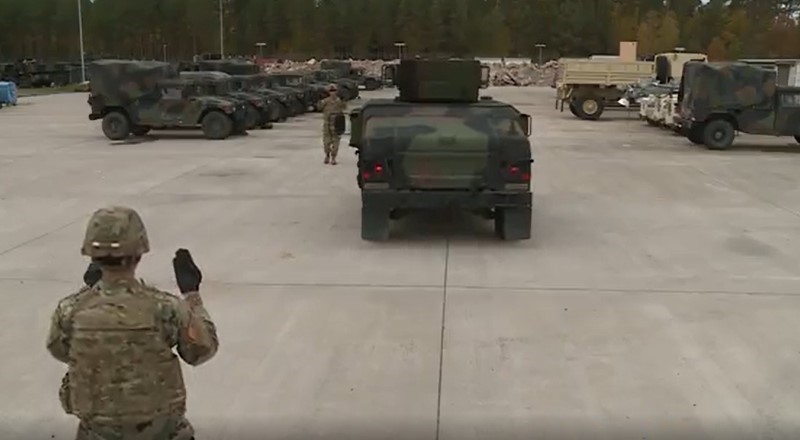 Photo courtesy of USACRC
Photo courtesy of USACRC
Warfighters, MSG Half-Mast requests you huddle up with your fellow Soldiers and remind them that driving tactical/ground vehicles is serious business. Just how serious is it?
A Government Accountability Office (GAO) report from July 2021 found 123 service members died in non-combat-related accidents between FY10 and FY19. Sadly, we’re seeing this trend continue.
The GAO report identified the three most common causes of tactical driving accidents:
- Driver inattentiveness
- Lapses in supervision
- Lack of training
Driver Inattentiveness
When operating a tactical vehicle, your attention must be focused on that vehicle at all times — not thinking about what you’re doing over the weekend or what sounds good for lunch! Watch the road, glance at your gauges occasionally to make sure your speed is right and focus your attention on the road ahead. Keep an eye out for changing road conditions like hills and downgrades, obstacles, curves and other vehicles.
Co-drivers and occupants in a tactical vehicle should sound off if they notice a driver operating a vehicle at excessive speed or not paying attention to the road. It could save everyone’s life.
Seat belt use is not an option. It’s not just the responsibility of leadership to ensure 100% seat belt and restraint use in tactical vehicles, it’s everyone’s responsibility. Given the size and weight of today’s Army and Marine Corps tactical vehicles, the risk of rollover and rollover fatalities has never been greater. In the event of a vehicle rollover, your seat belts and restraints, along with engaged safety latches, are your first line of defense to prevent major injuries. Using them correctly can save your life. Not using them correctly is simply not an option.
IMPORTANT NOTE: Since FY18, no Soldier that was correctly using a properly functioning restraint system has died in a tactical vehicle mishap.
Driving on a nice, sunny day on a smooth surface is about as easy as it gets, right? However, we all know the mission often has us driving in less than optimal conditions. What about driving on the range during a hard rain on muddy tank trails? What about driving at night while it’s snowing or driving down steep mountain roads in three feet of snow?
Let’s talk about unimproved roads. Why? Because they can be challenging in good or bad weather for even an experienced driver. In wet weather, they tend to be slippery and deep ruts or holes can be hidden under puddles. In dry weather they can create a dust hazard, especially when following behind another vehicle or in a convoy. This means potentially losing sight of other vehicles or the taillights and stoplights of the vehicle in front of you.
Those are just a few conditions you’ll likely face when driving tactical vehicles, and you’ll need to be focused and ready to tackle them confidently and safely. For some great driving tips, look at
Tactical Vehicles: Don’t Make Winter Driving a Chilling Experience. The article isn’t just about winter driving. It also covers braking and the various types of brakes and how best to utilize them.
Lapses in Supervision
Leaders, you’ll need to validate your unit’s driver training program to make sure you’re following the guidance in AR 600-55, The Army Driver and Operator Standardization Program (Selection, Training, Testing, and Licensing) (Sep 19).
It’s critical that leaders employ risk management for all missions. This means real-time risk management even for “routine” missions that involve operating tactical vehicles, even under the best conditions. More often than not, it’s the “routine” missions where complacency sets in, which only leads to trouble.
To help your Soldiers become more confident and safer when driving tactical vehicles, ensure you certify junior leaders to conduct troop leading procedures (TLPs). Junior leaders may themselves be rather inexperienced when it comes to safe driving. Leaders need to rigorously train their junior leaders, hold them to high standards and, in turn, ensure they hold their Soldiers to high standards.
Make sure junior leaders know how to plan vehicular movements and how to lead rehearsals. It’s also critical they know how to conduct pre-combat checks (PCCs) and pre-combat inspections (PCIs).
Lack of Training
Unit leadership should routinely check the health of their driver training program to ensure they’re following the guidance and standardization of training, testing and licensing covered in AR 600-55.
Don’t forget the US Army Combat Readiness Center (USACRC) developed a driver’s toolbox to assist in the management of driver training. To access the toolbox, have your CAC handy and go
HERE.
While it’s important to have junior leaders know how to conduct PCCs and PCIs, it’s also important for tactical vehicle drivers to know these procedures.
Make sure your drivers are actively participating in rehearsals and cover risk management with them. Ask your driver questions like, “What are some risks you’ll face while driving during the FTX next month?” or “This is your first time driving the FMTV with a trailer; do you have any concerns and how can you address them properly?”
Take the time to make sure your drivers are trained on these areas and revisit them in training regularly:
- Ground guiding (during day and night operations). Watch the USACRC ground guide video.
- Pulling or towing other vehicles and trailers
- The impact payload has on vehicle center of gravity
- Rollover risk
- Weather conditions and how they impact road surfaces
- Braking (different types of brakes and how to use them)
- Speed awareness and control
Lack of Tactical Driving Experience